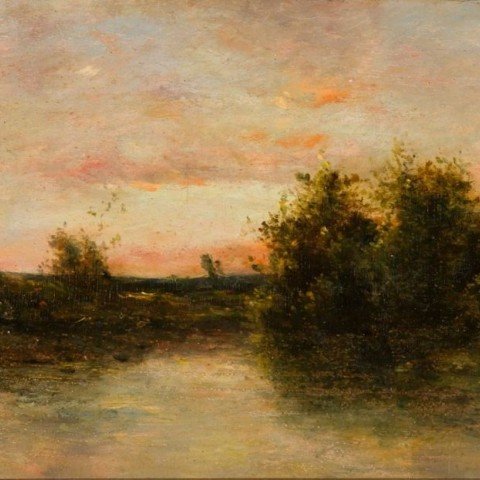A French landscapist of the Barbizon School, Charles-Francois Daubigny was born in 1817 in Paris. In 1835, having received a small scholarship, he went to Italy, where he spent an unproductive year. He earned a living by doing engravings for books and regularly sent to the Salon peaceful landscapes, painted in a highly detailed style, with great respect for nature.
In the 1840s, Daubigny worked for travel books and magazines, doing graphics of a candidness that showed his immediate vision of nature, increasingly dependent on fleeting optical visions. As a successor to Corot, Dupre and Rousseau, he attracted the attention of critics. Gradually, he began to sacrifice detail, painting with broad strokes and covering large areas at a time. As time went on, Daubigny's manner became lighter and freer. His last canvases reflect the spirit of the impressionists, if not their technique. Unlike his forerunners Claude Lorrain and Nicolas Poussin, the gentle naturalist looked more to the effects of nature than to rearranging its contours into earthen architecture. He sketched directly from nature, in the volative light and weather of the moment.
There was something exceptionally attractive about Daubigny, both as a man and as an artist. A painter with a style that concealed all innovations in apparent conventionality, he easily achieved popularity with the public and was elected to the jury of the Salon. There he waged a loyal and lonely fight to admit to the annual exhibitions the work of the younger and more radical painters. During the Franco-Prussian War, he fled to England, where he persuaded his dealer, Durand-Ruel, who had opened a gallery in London, to try to sell the landscapes of an unknown and poverty-stricken artist, Claude Monet. Daubigny offered to exchange his own marketable canvases for any work by Monet that remained unsold.
The place Daubigny loved best was the village of Auver-sur-Oise, to which he returned every year. Aboard his barge, a floating studio, he sometimes went down the Oise and the Seine. In 1865, he spent the summer with Courbet, Monet and Boudin at Trouville. He died in 1878 in Paris.
Compiled and submitted August 2004 by Jean Ershler Schatz, artist and researcher from Laguna Woods, California.
Sources include:
Time Magazine, May 15, 1964
Phaidon Encyclopedia of Art and Artists
John Walker, Chief Curator, National Gallery of Art, from a review of "The Farm"

